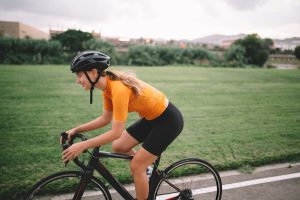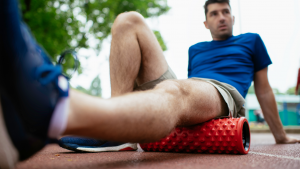No products in the cart.
Stretching: Good Plan, Better Body, Best Athlete
In recent years a very heavy focus has been put on recovery and training. With that the focus has become more and more prevalent in endurance sports as well. Whether it is a post exercise drink, compression socks or the latest pill designed to aid recovery many will spend whatever it takes. All money aside, an often neglected aspects of recovery is stretching. We know that after a long ride, run or swim all you want to do is eat, get cleaned up and relax. While this is all good, adding a short stretching routine to your post-ride ritual can go a long way towards aiding recovery, preventing injury and maybe even gaining a little power on your next ride. The goal in stretching is to counteract the cycling posture and limited range of motion in the pedal stroke. If your muscles are not being used in their full range of motion they will shorten and become tight. That’s why often at the end of a long ride it can take a little effort to stand upright or bend your legs fully. By stretching them back out they retain their full range of motion. The Benefits: Our bodies are designed to move in a full range of motion. On the bike, we are confined to a very limited range of motion: the upper body is bent forward and moves very little while the legs never fully extend or contract during the pedal stroke and so the muscles are shorter (“tighter”) than when you started. Just like the spokes on a wheel the musculature of the human body keeps us upright and functional through counter-tension. When the origin and insertion points of a muscle are brought closer, the muscle shortens in order to maintain this tension. When a muscle is chronically tight (i.e. not capable of fully extending and contracting) it throws the entire system off balance. That’s why when you have lower back troubles what first starts in your lower back can begin to creep down your leg and can creep all the way up to your neck if the issue is not addressed. If you are one of the lucky few and you’ve never experienced any soreness whatsoever or have no idea what I’m talking about, I can only say that prevention is a heck of a lot cheaper than treatment. But most people, from recreational riders to top pro tour riders, can all benefit from stretching. Not only for injury prevention but for power as well, a tight muscle requires more energy to move. Loose and healthy muscles need less energy. Meaning it takes less effort to transfer force to the pedal. When to Stretch Within about 15min of finishing your ride so the muscles are still warm. Stretching muscles that haven’t been properly warmed up can lead to injury, so you want to make sure you haven’t cooled down too much before you stretch. Get cleaned up, get some hydration and get started. (I could write an entire article on hydration. But to be brief, it’s one of the easiest and most important ways you can take care of your muscles. Proper hydration throughout the day prevents injury and helps flush lactic acid from the muscles. It’s water, it’s totally free and it’s everywhere.) Sample Routine The goal in stretching is to counteract the cycling posture and limited range of motion in the pedal stroke. If your muscles are not being used in their full range of motion they will shorten and become tight. That’s why often at the end of a long ride it can take a little effort to stand upright or bend your legs fully. By stretching them back out they retain their full range of motion. More important than stretching as deeply as you think you can is the length of time you hold the stretch. This isn’t about challenging yourself, that’s what the bike is for. Think of this as an opportunity to let your body know that you are still friends after you just abused it for hours on end. Find the point in the stretch when you start to feel it, but can comfortably hold it while breathing normally. Hold each stretch for 20sec to a minute (or longer if it feels particularly tight). You should be able to breathe fully and deeply. If you find yourself holding your breath or have difficulty breathing normally, back off until you can breathe comfortably. Side Stretch
Standing up straight, bring your arms up over head and clasp your hands together with palms facing outward (towards the ceiling). Deep breath in and on the slow exhale, bend sideways keeping your arms stretched overhead. Hold stretch and maintain normal breathing Chest Opening
Standing upright, clasp hands behind back. Keeping your hands clasped with your arms straight, slowly raise your arms while extending your chest forward and up. Downward Dog
Laying on your stomach, push your upper body off the ground with your arms and hold. Feet can either be flat on the ground as in the picture or for a little deeper stretch you can push up onto the balls of your feet. Supine Hamstring
Lying on your back raise one leg while keeping the other flat on the ground. Keeping the leg straight raise it high as you can, grasping it with your hands. Seated Hamstring
Sitting on the floor with both legs straight out in front of you. Keeping your back straight, slowly lean forward reaching for your shins or ankles. Once you reach a point where you feel the stretch in the back of your legs you can lower your head to stretch your neck. Supine ITB Stretch
Lying on your side with your legs stacked on top of each other, take the top leg and bring it out in front until it’s at a 90 degree angle to the rest of your body (leg can be either straight or bent depending on flexibility). To deepen the stretch, turn neck and torso away from top leg. Seated ITB Stretch
Sitting on the floor with both legs straight in front of you, bend your right leg and cross over the left leg, placing the heel of your right foot next to the left knee (or closer to your hip depending on flexibility). Next, turning to the right, place your left elbow on the outside of your right knee and use it to push into the stretch, keeping your right hand on the ground for stability. Repeat on the opposite side. Runner’s Lunge
Standing straight up, bend forward and place hands on ground on either side of feet, step one leg straight behind while front leg bends at a 90 degree angle (make sure the front knee does not extend beyond the toes). Keep the back leg straight behind resting on the ball of your foot or lower your back knee to the ground depending on flexibility. In just 10-15 minutes everyday (or at least after every workout) you can do yourself a world of good and keep riding strong all the way to the end of the season. If you have any questions be sure to contact us at scienceofspeed.org PHOTOS BY ALICIA OSBORNE (aliciaosbornephoto.com)











